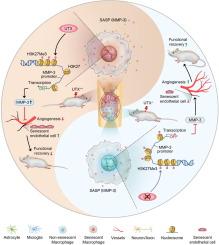KDM6A/MMP-3 epigenetic axis governs macrophage senescence after spinal cord injury for mediating the regenerative niche to promote neurological repair
IF 13
1区 综合性期刊
Q1 MULTIDISCIPLINARY SCIENCES
引用次数: 0
Abstract
Introduction
Spinal cord injury (SCI) stands as the primary cause of disability, still lacking a clear pathogenesis and effective treatment. The role of macrophages is particularly unclear in SCI, especially regarding cellular senescence. Additionally, the mechanisms driving macrophage senescence after SCI, the release of senescence-associated secretory phenotype (SASP) factors that affect the regenerative niche, and their contributions to SCI progression remain elusive.Objectives
To investigate the role and underlying mechanism of Ubiquitously transcribed tetratricopeptide repeat X chromosome (UTX) in regulating macrophage senescence following SCI.Methods
A contusive SCI model was constructed to explore the presence of senescent macrophages. After screening for UTX by a PCR array, conditioned knockout UTX mice (LysM-Cre; UTXflox/flox) was constructed to explore the effect of UTX on macrophage senescence to influence angiogenesis and neurological function. Furthermore, RNA-seq and ChIP-seq were carried out to screen the downstream target gene Matrix Metalloprotease-3 (MMP-3). At last, RNA-seq was performed to explore the effect of MMP-3 on endothelial cells in vitro.Results
An elevated presence of lysine demethylase 6A (Kdm6a/UTX), a special epigenetic regulatory modifier, was observed in macrophage senescence after SCI. Conditional deletion of UTX not only prevented macrophage senescence, but also enhanced the formation of a regenerative niche that protected endothelial cells from senescence and improved their proliferation. Mechanistically, UTX epigenetically regulated MMP-3 transcription through demethylating histone H3 lysine di/trimethylation (H3K27me2/3) at its promoter region. This led to senescent macrophages releasing MMP-3, a key SASP factor that disrupts the local microenvironment and impairs spinal cord repair post-injury. Notably, MMP-3 could act as a pro-senescent agent by senescent macrophages to propagate cellular senescence in endothelial cells (ECs), exacerbating cellular senescence in the injured region.Conclusions
Our findings elucidate the KDM6A/MMP-3 epigenetic regulatory axis, which governs macrophage senescence and shapes a pro-regenerative microenvironment after SCI. Targeting this pathway promotes angiogenesis and facilitates neural repair, highlighting its potential as a therapeutic target for improving functional recovery after SCI.

KDM6A/MMP-3表观遗传轴调控脊髓损伤后巨噬细胞衰老,介导再生生态位促进神经修复
脊髓损伤(SCI)是致残的主要原因,目前仍缺乏明确的发病机制和有效的治疗方法。巨噬细胞在脊髓损伤中的作用尤其不清楚,尤其是在细胞衰老方面。此外,脊髓损伤后巨噬细胞衰老的驱动机制、影响再生生态位的衰老相关分泌表型(SASP)因子的释放以及它们对脊髓损伤进展的贡献尚不清楚。目的探讨泛素转录四肽重复 X 染色体(UTX)在脊髓损伤后巨噬细胞衰老中的作用及其机制。方法建立挫伤性脊髓损伤模型,观察衰老巨噬细胞的存在。通过PCR阵列筛选UTX后,构建条件敲除UTX小鼠(LysM-Cre; UTXflox/flox),探讨UTX对巨噬细胞衰老的影响,从而影响血管生成和神经功能。通过RNA-seq和ChIP-seq筛选下游靶基因基质金属蛋白酶-3 (Matrix Metalloprotease-3, MMP-3)。最后,采用RNA-seq方法探讨MMP-3对体外内皮细胞的影响。结果在脊髓损伤后巨噬细胞衰老过程中,一种特殊的表观遗传调控因子赖氨酸去甲基化酶6A (Kdm6a/UTX)表达升高。条件缺失UTX不仅可以阻止巨噬细胞衰老,还可以促进再生生态位的形成,从而保护内皮细胞免于衰老并促进其增殖。在机制上,UTX通过在其启动子区域去甲基化组蛋白H3赖氨酸二/三甲基化(H3K27me2/3)来表观遗传调节MMP-3的转录。这导致衰老的巨噬细胞释放MMP-3,这是一个关键的SASP因子,破坏局部微环境并损害脊髓损伤后的修复。值得注意的是,MMP-3可以作为促衰老剂通过衰老巨噬细胞在内皮细胞(ECs)中传播细胞衰老,加剧损伤区域的细胞衰老。结论我们的研究结果阐明了KDM6A/MMP-3表观遗传调控轴在脊髓损伤后巨噬细胞衰老和形成促再生微环境中的作用。靶向该通路促进血管生成,促进神经修复,突出了其作为改善脊髓损伤后功能恢复的治疗靶点的潜力。
本文章由计算机程序翻译,如有差异,请以英文原文为准。
求助全文
约1分钟内获得全文
求助全文
来源期刊

Journal of Advanced Research
Multidisciplinary-Multidisciplinary
CiteScore
21.60
自引率
0.90%
发文量
280
审稿时长
12 weeks
期刊介绍:
Journal of Advanced Research (J. Adv. Res.) is an applied/natural sciences, peer-reviewed journal that focuses on interdisciplinary research. The journal aims to contribute to applied research and knowledge worldwide through the publication of original and high-quality research articles in the fields of Medicine, Pharmaceutical Sciences, Dentistry, Physical Therapy, Veterinary Medicine, and Basic and Biological Sciences.
The following abstracting and indexing services cover the Journal of Advanced Research: PubMed/Medline, Essential Science Indicators, Web of Science, Scopus, PubMed Central, PubMed, Science Citation Index Expanded, Directory of Open Access Journals (DOAJ), and INSPEC.
 求助内容:
求助内容: 应助结果提醒方式:
应助结果提醒方式:


